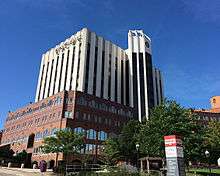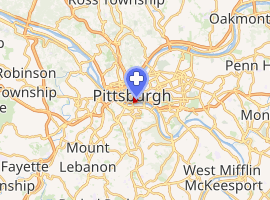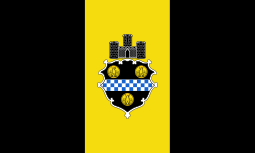UPMC Mercy
UPMC Mercy is a main hospital facility of the University of Pittsburgh Medical Center (UPMC) and is located in the Uptown section of the city of Pittsburgh, Pennsylvania, adjacent to Duquesne University, and a few blocks from the PPG Paints Arena and downtown Pittsburgh. It is the first chartered hospital to have been founded in the city of Pittsburgh and it is also the first hospital in the world to have been established by the Sisters of Mercy. It is also the first teaching hospital in the region, accepting residents to teaching positions beginning in 1848, one year after opening its doors.
| UPMC Mercy | |||||||||||
|---|---|---|---|---|---|---|---|---|---|---|---|
| University of Pittsburgh Medical Center | |||||||||||
 | |||||||||||
 | |||||||||||

| |||||||||||
 Location of UPMC Mercy in Downtown Pittsburgh | |||||||||||
| Geography | |||||||||||
| Location | Pittsburgh, Pennsylvania, United States | ||||||||||
| Coordinates | 40.4363°N 79.9851°W | ||||||||||
| Organization | |||||||||||
| Funding | Non-profit hospital | ||||||||||
| Type | Teaching | ||||||||||
| Affiliated university | University of Pittsburgh School of Medicine The Mercy Hospital School of Nursing | ||||||||||
| Services | |||||||||||
| Emergency department | Adult Level I | ||||||||||
| Beds | 404 | ||||||||||
| Helipads | |||||||||||
| Helipad | FAA LID: PN23[1] | ||||||||||
| |||||||||||
| History | |||||||||||
| Opened | January 1, 1847 | ||||||||||
| Links | |||||||||||
| Website | www | ||||||||||
| Lists | Hospitals in Pennsylvania | ||||||||||
| Official name | Mercy Hospital | ||||||||||
| Designated | May 27, 1994[2] | ||||||||||
In January 2008, Mercy Hospital merged with Pittsburgh health care giant UPMC, taking on its current name UPMC Mercy. UPMC Mercy remains Pittsburgh's only Catholic hospital that provides a full breadth of specialized services.
History
The Sisters of Mercy, a religious congregation founded in Ireland in 1831 by Catherine McAuley, brought its stated mission of caring and compassion to the growing industrial city of Pittsburgh in 1843. Mother Frances Warde led six other sisters to the United States, where they founded the first congregation of the Sisters of Mercy in Pittsburgh. The pioneering "Seven Sisters" of Mercy opened the first permanent hospital in Pittsburgh, and the world’s first Mercy Hospital, on January 1, 1847.[3] Founded by Bishop Michael O'Connor, it began life in a temporary frame building on Penn Avenue known as Concert Hall.[4] The hospital they established was open to all regardless of race, nationality, age, gender, or religion. Mercy established the region’s first teaching hospital with resident physicians in training in 1848.
Mercy Hospital grew rapidly with Pittsburgh in the second half of the nineteenth century. To qualify for new funding sources, the hospital was incorporated, a board was established, and Thomas M. Carnegie was elected board president. The Sisters of Mercy and the physicians and nurses of Mercy Hospital continued to serve the Pittsburgh region through World War I, the worldwide epidemic of Spanish influenza, the Great Depression, and World War II. One of the most compelling examples of the hospital's service to the community occurred in 1931 when Mercy Hospital donated more than $600,000 ($10,087,090 today) worth of health care services at a time when one day in the hospital cost less than $4 ($67.25 today). That commitment to the community was demonstrated again when, in the 1960s, Mercy decided to rebuild and remain in uptown Pittsburgh, and over the next four decades, the hospital expanded, replaced facilities, and developed specialized programs and advanced technology.

In 2006, Mercy Hospital decided to seek a strategic partner to strengthen and preserve its faith-based care and Mercy Hospital of Pittsburgh merged with UPMC to become UPMC Mercy on January 1, 2008. The hospital remains Pittsburgh’s only Catholic hospital with specialized services, including the neurosciences, Level I trauma and burn services, women’s health, orthopaedics, and physical medicine and rehabilitation.[5][6]
Mission
From its inception in 1847, the hospital has welcomed and served all who are in need of its services regardless of race, nationality, age, gender or religion. UPMC Mercy continues to provide significant amounts of unreimbursed healthcare to the poor and uninsured in Pittsburgh and to the entire Western Pennsylvania region. The Mission of the hospital includes "a commitment to being a transforming, healing presence within the communities we serve".
Core values
UPMC Mercy embraces the following seven "core values" that are at the heart of its daily operation:
- Reverence for each person,
- Community support,
- Justice for all,
- Commitment to those who are poor,
- Stewardship,
- Courage,
- Integrity.
As a Catholic hospital, UPMC Mercy will not provide or permit medical procedures that are contrary to the teachings of the Roman Catholic Church, thus not providing some procedures available at other UPMC facilities.[7]
Major programs
UPMC Mercy Hospital is a Level I Trauma and Burn Center, a major neurosurgical center, and a major cardiovascular treatment center that also has recently acquired unique expertise and advanced technology for the diagnosis and treatment of stroke and neurovascular disorders.
UPMC Mercy provides inpatient Behavioral Health services, on both a General Adult unit and a Dual Diagnosis unit.
Level 4A Medically Managed Inpatient Detox services have been offered at UPMC Mercy since January 2010, as a result of the closure of UPMC Braddock that month. Although both Level 4A (Medically Managed) and Level 3A (Medically Monitored) Inpatient Detox had been available on the UPMC Braddock premises, Level 3A services are not available at UPMC Mercy.
It also incorporates a fully accredited and internally contained 76-bed rehabilitation center for the treatment of various forms of pathology producing physical disabilities, with specialty rehabilitation programs that address acquired brain injury, stroke, spinal cord injury, and Limb Amputation.
UPMC Mercy Hospital offers physician residency training programs in the fields of General Surgery, Internal Medicine, Podiatry, Physical Medicine and Rehab, and Pharmacy.
Internal Medicine Residency Program
Internal medicine residency program is the largest residency program of the institution, with more than 50 first, second and third year categorical residents. The program director is Dr. Anthony J Pinevich. The program includes rotations at UPMC Mercy Hospital and the Mercy Health Center.
Prominent patients
Ben Roethlisberger is a past patient. In a statement released on June 15, 2006 through the Pittsburgh Steelers organization following his treatment at Mercy Hospital for injuries sustained in a motorcycle accident in downtown Pittsburgh on June 12, 2006, Mr. Roethlisberger included the following acknowledgment: "The physicians and support staff at Mercy Hospital were simply amazing, and I will forever be grateful for their caring treatment."
In March 1983, Pittsburgh Penguins coach/GM and Pittsburgh Hornets legend Baz Bastien was rushed to the hospital after crashing into a motorcycle on Interstate 376 in suburban Greentree, Pennsylvania.[8]
References
- "AirNav: PN23 - University of Pittsburgh Medical Center Mercy Heliport". Retrieved 8 July 2017.
- "PHMC Historical Markers Search" (Searchable database). Pennsylvania Historical and Museum Commission. Commonwealth of Pennsylvania. Retrieved 2014-01-25.
- Houser, Mark (2008-01-06). "Nurses of Mercy sacrificed lives in 1848 epidemic". Pittsburgh Tribune-Review. Pittsburgh, PA. Retrieved 2009-08-10.
- Diller, Theodore (May 1927). "Hospitals, Schools and Journals". Pioneer Medicine in Western Pennsylvania. New York: Paul B. Hoeber, Inc. p. 204. Retrieved 2010-10-11.
- "UPMC Mercy: Mission and History". Retrieved 2009-08-10.
- "UPMC, Mercy: A chronology". Pittsburgh Post-Gazette. Pittsburgh, PA. 2006-09-21. Retrieved 2009-08-10.
- "What Does It Mean to be a Catholic Hospital?". UPMC.com. Retrieved 2011-05-16.
- "Williamson Daily News - Google News Archive Search". news.google.com.
External links
| Wikimedia Commons has media related to UPMC Mercy. |
